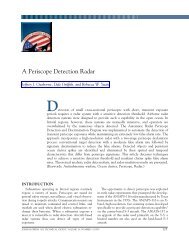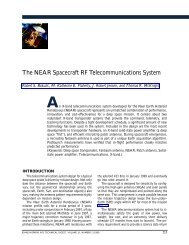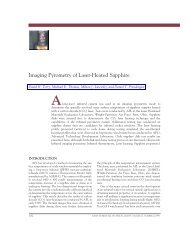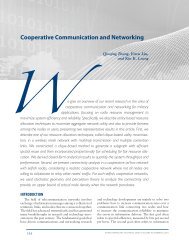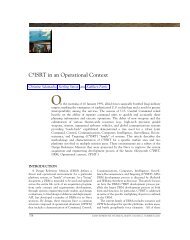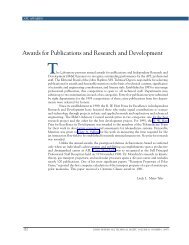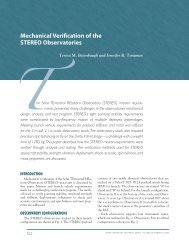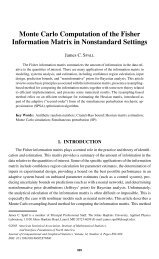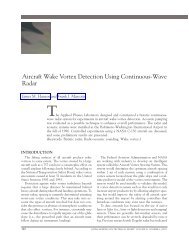Aerospace Nuclear Safety at APL - The Johns Hopkins University ...
Aerospace Nuclear Safety at APL - The Johns Hopkins University ...
Aerospace Nuclear Safety at APL - The Johns Hopkins University ...
- No tags were found...
You also want an ePaper? Increase the reach of your titles
YUMPU automatically turns print PDFs into web optimized ePapers that Google loves.
Y. CHANGstarting above 1920 m (6300 ft). <strong>The</strong> probabilities ofnear-pad ground impact conditions (orient<strong>at</strong>ion andimpact velocity) of the spacecraft and third stage as afunction of time of accident were reported in the SARd<strong>at</strong>abook. <strong>The</strong> FSAR used these impact conditions indetermining the responses of the RTG upon hitting theground.If the spacecraft <strong>at</strong>tains park orbit, but an accidentprevents it from escaping orbit, then the spacecraft’sorbit will decay because of <strong>at</strong>mospheric drag and it willreenter within days. For reentry breakup from orbitaldecay, <strong>APL</strong> calcul<strong>at</strong>ions showed th<strong>at</strong> the RTG andspacecraft would break up and separ<strong>at</strong>e from the CSCsbefore the CSCs’ thermally induced auto-ignition.Reentry breakup analyses of the spacecraft and RTGwere also conducted for the launch contingency effort 5and are described l<strong>at</strong>er in this article.If the spacecraft is injected into a heliocentric orbitfollowing an accident, it could potentially impact Earthin the future. <strong>APL</strong> conducted a study on long-term Earthreentry probabilities, where “long term” is defined as 1000years. Considering th<strong>at</strong> the half-life of Pu-238 is 87.7years, 1000 years transl<strong>at</strong>es into 11.4 half-lives, and theactivity of the Pu-238 <strong>at</strong> the end of 1000 years would beabout 0.04% of its activity <strong>at</strong> the beginning. <strong>The</strong> resultsof the study showed th<strong>at</strong> the probability of a long-termEarth reentry, once the spacecraft was in heliocentricorbit, was on the order of 10 –4 ; this can be reduced by 3orders of magnitude if a trajectory correction maneuverwith a 4V of 100 m/s is applied. 6 <strong>The</strong>se probabilities oflong-term reentry were used in the accident probabilitiessection of the New Horizons SAR d<strong>at</strong>abook.CSC TestingTwo CSCs, each with 500 g of plastic explosive, arepart of the New Horizons STAR 48B BUS, which in turnis part of the launch vehicle’s FTS. In the event of anFTS activ<strong>at</strong>ion, including a BUS activ<strong>at</strong>ion as describedin the last section, the CSCs could eject backside metalcasing fragments toward the RTG <strong>at</strong> estim<strong>at</strong>ed velocitiesof around 3.0 km/s (1.9 mi/s). Thus CSC testing was initi<strong>at</strong>edby NASA to determine if these fragments wouldhave any harmful effects. <strong>APL</strong> particip<strong>at</strong>ed in the CSCtesting, which was conducted <strong>at</strong> China Lake, California.<strong>The</strong> CSC test setup (Fig. 2a) followed an April 2004<strong>APL</strong>-written test proposal, which also predicted th<strong>at</strong>the CSC fragments would not be harmful to the RTGbecause of the oblique angles <strong>at</strong> which the fragmentswould impact the RTG housing. <strong>The</strong> test setup replic<strong>at</strong>edthe flight configur<strong>at</strong>ion, specifically the m<strong>at</strong>erial,structural, and geometric arrangements of the two CSCsinside the bottom of the lower payload <strong>at</strong>tach fitting(PAF) and the simulant packs for the RTG. Because ofcyclical symmetry, four simulant packs can each representthe RTG loc<strong>at</strong>ion for each test firing. <strong>APL</strong> designedand fabric<strong>at</strong>ed the simul<strong>at</strong>ors for the PAFs, as well asthe internal brackets for the CSCs and shields. SouthwestResearch Institute (SwRI) conducted independentCSC tests <strong>at</strong> their facility in San Antonio, Texas, whichprovided valuable insight in designing the China Laketests. For the China Lake tests, SwRI also providedthe design and fabric<strong>at</strong>ion of the boron carbide shields(Fig. 2b), which would be incorpor<strong>at</strong>ed as third-stageflight hardware if the unmitig<strong>at</strong>ed CSC fragmentsturned out to be harmful.<strong>The</strong>re were three identical test firings without theshields <strong>at</strong> China Lake in November 2004, for a total of12 RTG simulant test articles. <strong>The</strong>se test results showedth<strong>at</strong> the fragments gener<strong>at</strong>ed by the deton<strong>at</strong>ion of theCSCs were unlikely to damage the graphitic m<strong>at</strong>erialof the GPHS modules encasing the nuclear fuel of theRTG. Thus the proposed shields were not implementedon the flight hardware. <strong>The</strong>se conclusions were reportedin the New Horizons SAR d<strong>at</strong>abook and cited by theINSRP in the New Horizons SER.(a)(b)Figure 2. (a) CSC test setup <strong>at</strong> China Lake. <strong>The</strong> RTG simulant pack is constructed with a 2219 aluminum face sheet and 1.27-cm-thick (0.5-in.-thick) Celotex sheets. (Any Celotex damage was a criterion for adding shielding to the next test.) (Photo courtesy of NASA/JPL.) (b) CSCboron carbide shield configur<strong>at</strong>ion in the third-stage PAF.256<strong>Johns</strong> <strong>Hopkins</strong> <strong>APL</strong> Technical Digest, Volume 27, Number 3 (2007)
SOLID PROPELLANT FIRE<strong>The</strong> 17 January 1997 near-pad in-air explosion ofthe Delta II 241 rocket over Cape Canaveral reinforcedthe concept th<strong>at</strong> a near-pad launch accidentcan result in solid rocket propellant burning in ambient<strong>at</strong>mospheric conditions on the ground, possiblynear the RTG or RTG components. Characteristicsof burning solid propellant are high temper<strong>at</strong>ure, longdur<strong>at</strong>ion (up to several minutes), and persistence (doesnot dissip<strong>at</strong>e). Earlier characteriz<strong>at</strong>ions of solid propellantfires were of less energetic propellants (about7000 kJ/kg) compared to the more energetic propellants(about 9300 kJ/kg) used in modern solid rocketpropellant formul<strong>at</strong>ions. 7 Earlier tests characterizedthe environment above a propellant fragment burningonly on its top surface. However, the <strong>at</strong>-risk hardwareof the RTG most likely would be on the ground, underne<strong>at</strong>hor adjacent to a propellant fragment burning on itstop, bottom, and side surfaces. Thus there was a need tobetter characterize the n<strong>at</strong>ure of solid propellant fires.To address this need, <strong>APL</strong> conducted a solid propellantfire-testing program in 1999–2001 using more than25 individual burns with various geometries, burn configur<strong>at</strong>ions,and instrument<strong>at</strong>ion. <strong>The</strong> test setup of a91-kg (200-lb) cylinder of propellant is shown in Fig. 3a.<strong>The</strong> vertical rod <strong>at</strong>tached to the top of the propellanttest article allowed vertical movement but preventedl<strong>at</strong>eral movement if the hot gasses eman<strong>at</strong>ing from thepropellant underside were forceful enough for the blockto self-levit<strong>at</strong>e. <strong>The</strong> in situ instrument<strong>at</strong>ion installed inthe ground under and surrounding the propellant massconsisted of rod calorimeters, slug calorimeters, witnessm<strong>at</strong>erials, bare thermocouples, and a two-color pyrometeroper<strong>at</strong>ing in the near-IR. <strong>The</strong> remote instrument<strong>at</strong>ionconsisted of UV/visible and mid-wave IR (MWIR)spectroradiometer measurement systems and visible,MWIR, and longwave IR (LWIR) cameras. <strong>The</strong> MWIRwavelength range was 3–5 mm, and the LWIR rangewas 8–12 mm. A LWIR test image is shown in Fig. 3b.AEROSPACE NUCLEAR SAFETY AT <strong>APL</strong>: 1997 –2006Post-test analysis of the LWIR d<strong>at</strong>a and the calorimeterand thermocouple d<strong>at</strong>a indic<strong>at</strong>ed th<strong>at</strong> plume temper<strong>at</strong>uresreached 3000 ± 100 K and he<strong>at</strong> fluxes reached 200± 80 W/cm 2 .Test results, which were reported in the d<strong>at</strong>abooksand in Ref. 7, provided the peak temper<strong>at</strong>ures (up to3100 K) for the solid propellant fire specific<strong>at</strong>ion inthe Mars Explor<strong>at</strong>ion Rovers (MER) SAR d<strong>at</strong>abookin 2002. <strong>APL</strong>’s analysis of the test results continuedinto 2004. <strong>The</strong> Labor<strong>at</strong>ory developed a fire model foraluminized propellant fires based on the physics of thephenomena in an aluminized propellant fire. 8 Modelpredictions were consistent with test results. <strong>The</strong> <strong>APL</strong>fire model was then used to produce a solid propellantfire specific<strong>at</strong>ion for the New Horizons SAR d<strong>at</strong>abooksin 2004 and 2005; this specific<strong>at</strong>ion was carriedover into the Mars Science Labor<strong>at</strong>ory (MSL) SARd<strong>at</strong>abook in 2006. <strong>The</strong> specific<strong>at</strong>ion provided a rangeof propellant fragment sizes and masses, specified thetemper<strong>at</strong>ures as functions of time and loc<strong>at</strong>ion for eachpropellant size, and was used to develop the New HorizonsFSAR. In addition, the test results were deemed tobe accur<strong>at</strong>e by INSRP in the New Horizons SER andwere a sufficient basis to develop the specific<strong>at</strong>ion.<strong>APL</strong> also provided test observ<strong>at</strong>ions, based on posttestm<strong>at</strong>erials analysis, th<strong>at</strong> were included in the SARd<strong>at</strong>abooks’ solid propellant fire specific<strong>at</strong>ion. A calorimeterof solid molybdenum metal melted <strong>at</strong> 2896 K servedas a temper<strong>at</strong>ure marker. Aluminized solid propellantfires produce aluminum oxide (Al 2O 3, or alumina). <strong>The</strong>responses of various witness m<strong>at</strong>erials near the propellantshowed th<strong>at</strong> aluminum oxide tended to dissolve andmerge with other oxides, such as silicon dioxide (silica)or sand, yttrium oxide (yttria), and cerium oxide (ceria).<strong>The</strong> merged liquid alumina and silica would be muchmore viscous than liquid alumina alone. An endothermicreaction of alumina with carbon was identified th<strong>at</strong>could lower the temper<strong>at</strong>ures of m<strong>at</strong>erials enclosed incarbon (such as a GPHS) by about 150 K.Figure 3. (a) Test setup with propellant block and in situ instrument<strong>at</strong>ion. (b) LWIR image of a solid propellant fire test.<strong>Johns</strong> <strong>Hopkins</strong> <strong>APL</strong> Technical Digest, Volume 27, Number 3 (2007)257
Y. CHANG<strong>The</strong> following test observ<strong>at</strong>ions were also reportedin Ref. 7. Measurements of the deposits downstreamand on a vertical rectangular witness board (shown tothe right of the propellant in Fig. 3) suggested th<strong>at</strong> fora ceria rod originally <strong>at</strong> a 28-cm (11-in.) radius, only34% of the mass merged with the local ground deposits,about 22% sprayed downstream onto the ground andthe board, and the remaining 44% was not recovered.At least part of the unrecovered ceria may have becomeairborne indefinitely. <strong>The</strong> post-test m<strong>at</strong>erials analysisprovided important insight into the behavior of RTGm<strong>at</strong>erials subjected to a solid propellant fire and theirthermal, chemical, and physical interactions with thecombustion products of the fire and the sand and concreteground m<strong>at</strong>erials.In March 2006, <strong>APL</strong> particip<strong>at</strong>ed in a Joint Army/Navy/NASA/Air Force workshop on Ambient AtmosphereSolid Propellant Combustion. Participantsincluded n<strong>at</strong>ional experts from government, universities,and industry. <strong>APL</strong> gave several invited keynote present<strong>at</strong>ionson the solid propellant fire modeling, solidpropellant fire tests, optical diagnostics overview andimplement<strong>at</strong>ion, and calorimetrics. <strong>The</strong>se were wellreceived by the workshop participants, who noted in theworkshop report th<strong>at</strong> the Labor<strong>at</strong>ory’s work provided avaluable contribution in th<strong>at</strong> the bottom-burning environment,which is the most severe environment for anobject, had not been considered before.NUCLEAR RISK ASSESSMENTSAs discussed in the boxed insert, DoE provides theNRAs as input to a mission’s EIS. Tetra Tech NUS, Inc.,under subcontract to <strong>APL</strong>, provided the NRAs in 2002for the NASA MER missions, in 2005 for the New Horizonsmission, and in 2006 for the MSL mission. In 2005,ASCA, Inc., also under subcontract to <strong>APL</strong>, providedthe EIS d<strong>at</strong>abook for the New Horizons mission, whichconsisted mainly of accident conditions and probabilities.In 2002, Tetra Tech NUS also provided the FSARfor the MER missions. 9 (Each MER rover carried eightradioisotope he<strong>at</strong>er units [RHUs] and no RTGs. <strong>The</strong>RHUs provide he<strong>at</strong> to the rovers’ electronics to allowtheir survival during the cold Martian nights. Each RHUcontains approxim<strong>at</strong>ely 2.7 g [about 0.1 oz] of PuO 2fuel,with an activity of 32.4 Ci, enclosed in a protective cladand graphitics. <strong>The</strong> cylindrically shaped RHU is 2.6 cm[1.0 in.] in diameter and 3.2 cm [1.3 in.] long, with a totalunit weight of about 40 g [1.4 oz]. 9 )LAUNCH CONTINGENCY EFFORTS<strong>The</strong> failure of the fourth stage carrying the RussianMars 96 spacecraft with four Russian RTGs, each containing200 g (7 oz) of Pu-238, resulted in Earth reentryin November 1996. According to the WashingtonPost, 10 the U.S. Space Command informed PresidentBill Clinton, who then warned the Australian PrimeMinister th<strong>at</strong> the spacecraft would impact Australia nearCanberra. But local Australian officials had alreadyalerted emergency teams 2 h earlier. Furthermore, thespacecraft debris had already landed a day earlier, not inAustralia but near the coast of Chile.This series of events demonstr<strong>at</strong>ed the need for realtimeproactive monitoring of a nuclear space launch andon-orbit trajectory until Earth escape. Specifically, thisexperience illustr<strong>at</strong>ed the need, after a reentry accident,for accur<strong>at</strong>e timing (when to expect Earth impact), timeliness(warning before, not after), and accur<strong>at</strong>e loc<strong>at</strong>ionprediction (where Earth impact would occur). <strong>The</strong>secapabilities were provided by <strong>APL</strong>’s Cassini launchcontingency effort 11 for the October 1997 launch. <strong>The</strong>Cassini spacecraft carried three GPHS-RTGs and 117RHUs. Before launch day, <strong>APL</strong> distributed to the communitya set of ballistic coefficients of the GPHS andRHU modules so th<strong>at</strong> the same inform<strong>at</strong>ion was used byall parties. (<strong>The</strong> ballistic coefficient of a body is a measureof its ability to overcome air resistance in flight.)<strong>APL</strong> provided the capability to predict the time ofspacecraft reentry from an orbital decay based on orbitalparameters from U.S. space tracking assets. In the eventof a suborbital or out-of-orbit reentry, U.S. space trackingassets would also provide the reentry conditions ofthe spacecraft. <strong>The</strong> breakup conditions of the spacecraftand RTG would be provided by JPL, the spacecraftmanager. <strong>APL</strong> would then predict the trajectory of theGPHS modules and RHUs released from the spacecraftas well as their Earth impact footprints via a threedegree-of-freedomtrajectory propag<strong>at</strong>ion code th<strong>at</strong> usedthe ballistic coefficients of the GPHS modules and theRHUs, all within an hour of reentry. <strong>The</strong>se predictionswould be used for notific<strong>at</strong>ion and recovery purposes.<strong>The</strong> contingency function was stood up <strong>at</strong> <strong>APL</strong>, and thecapabilities for predicting the reentry time and impactfootprints were brought online and staffed for launch,through ascension to park orbit, to final Earth escape.<strong>The</strong> launch and interplanetary injection were successful,and no contingency activities were needed.<strong>The</strong> same launch contingency efforts were plannedfor the two MER launches in June and July 2003. <strong>The</strong>MER rovers, Spirit and Opportunity, each carried eightRHUs, as noted earlier. In prepar<strong>at</strong>ion, <strong>APL</strong> improvedthe prediction capabilities by using a six-degree-of-freedomtrajectory propag<strong>at</strong>ion code, incorpor<strong>at</strong>ing winds,and valid<strong>at</strong>ing the code to predict the time of spacecraftreentry from an orbital decay. 12 Again, two successfullaunches precluded the need for intervention by the<strong>APL</strong> contingency team.To prepare for the New Horizons launch in January2006, <strong>APL</strong>’s launch contingency roles were expanded 13as part of NASA/DoE Radiological Contingency Planning.In addition to the tasks of the Cassini and MERlaunch contingency efforts, <strong>APL</strong> also wrote the contingencyplans for the debris impact footprint definition258<strong>Johns</strong> <strong>Hopkins</strong> <strong>APL</strong> Technical Digest, Volume 27, Number 3 (2007)
AEROSPACE NUCLEAR SAFETY AT <strong>APL</strong>: 1997 –2006and heliocentric orbit, particip<strong>at</strong>ed in the RadiologicalControl Center (RADCC) <strong>at</strong> the Kennedy SpaceCenter as the <strong>APL</strong> Payload Represent<strong>at</strong>ive, provided ahazardous elements picture book for first responders,developed capabilities for spacecraft and RTG breakuppredictions, 5 coordin<strong>at</strong>ed with U.S. space tracking assets,and reviewed pre-positioned cables to U.S. embassies.<strong>The</strong> Labor<strong>at</strong>ory distributed to the community a set ofballistic coefficients of third-stage and spacecraft individualcomponents th<strong>at</strong> could reenter so th<strong>at</strong> the sameinform<strong>at</strong>ion was used by all parties. <strong>APL</strong> also completedthe d<strong>at</strong>abase of full rot<strong>at</strong>ional aerodynamic coefficientsof the GPHS module to cover the supersonic and transonicflight regimes by comput<strong>at</strong>ional fluid dynamicsanalysis. <strong>The</strong>se coefficients supplemented existing subsonicand hypersonic wind tunnel d<strong>at</strong>a.<strong>The</strong> probability of a launch accident leading to asuborbital or orbital reentry was estim<strong>at</strong>ed <strong>at</strong> about 3%in the New Horizons FEIS, 3 with Earth impact possibleanywhere worldwide between 28.8°N and 28.8°S. <strong>The</strong>concept of oper<strong>at</strong>ions for the debris impact footprintprediction following a reentry is shown in Fig. 4, with anominal launch shown by the solid red line. In case of areentry accident, <strong>APL</strong> was to provide an Earth impactfootprint prediction in less than an hour. <strong>The</strong> footprintpredictions would be made by personnel <strong>at</strong> the EmergencyOper<strong>at</strong>ions Center on the <strong>APL</strong> campus and forwarded tothe <strong>APL</strong> Payload Represent<strong>at</strong>ive in the RADCC <strong>at</strong> the<strong>APL</strong>-FTP = <strong>APL</strong> Footprint Prediction Represent<strong>at</strong>ive<strong>APL</strong>-NAV = <strong>APL</strong> Navig<strong>at</strong>ion and Tracking Represent<strong>at</strong>ive<strong>APL</strong>-RADCC = <strong>APL</strong> Payload Represent<strong>at</strong>ive in the RADCC<strong>APL</strong>-SCR = <strong>APL</strong> Spacecraft Reentry Breakup Represent<strong>at</strong>iveCAR = Coordin<strong>at</strong>ing Agency Represent<strong>at</strong>iveCCAFS = Cape Canaveral Air Force St<strong>at</strong>ionC.MECOx = Centaur main engine cutoff 1 or 2C.MESx = Centaur main engine start 1 or 2CNN = Cable News Network (proxy for all news media)DHS = U.S. Department of Homeland SecurityDoE = U.S. Department of EnergyDoS = U.S. Department of St<strong>at</strong>eDSN = Deep Space NetworkEIF = Earth impact footprintFL = Florida st<strong>at</strong>e and local governmentofficialsGSFC = Goddard Space Flight CenterJPL = Jet Propulsion Labor<strong>at</strong>oryKSC = Kennedy Space CenterLV = Launch vehicleRADCC = Radiological Control Center <strong>at</strong> KSCSTA = U.S. space tracking assetsFigure 4. Debris impact footprint prediction concept of oper<strong>at</strong>ions. 13<strong>Johns</strong> <strong>Hopkins</strong> <strong>APL</strong> Technical Digest, Volume 27, Number 3 (2007)259
Y. CHANGlaunch site. <strong>APL</strong>’s footprint predictions would then bepassed on to NASA and DoE officials for notific<strong>at</strong>ion andrecovery purposes.<strong>The</strong> actual launch went off flawlessly. Thirteenmonths l<strong>at</strong>er, in February 2007, the New Horizonsspacecraft flew by Jupiter and g<strong>at</strong>hered scientific d<strong>at</strong>a onth<strong>at</strong> planet, its moons, rings, magnetosphere, and magnetotail.New Horizons is expected to fly by Pluto andCharon in July 2015, then past additional Kuiper Beltobjects a few years after th<strong>at</strong>, for our first close encounterswith these bodies.CONCLUSIONIt has been said th<strong>at</strong> more than 99% of our solarsystem is unexplorable without nuclear power. Past missionsenabled by space nuclear power have revealed someof the secrets held by the planets, their moons, and theedge of the solar system. Future missions to bodies in thesolar system and beyond to interstellar space could alsouse space nuclear power. <strong>APL</strong> has contributed to the aerospacenuclear safety of past missions and maintains thetechnical expertise to continue to do so in the future.ACKNOWLEDGMENTS. <strong>The</strong> <strong>Aerospace</strong> <strong>Nuclear</strong> <strong>Safety</strong> Program(ANSP) <strong>at</strong> <strong>APL</strong> is sponsored by Lyle Rutger ofDoE. <strong>The</strong> NASA NEPA compliance, launch approval,and launch contingency activities for the New Horizonsmission were sponsored by Kurt Lindstrom ofNASA Headquarters. <strong>The</strong> New Horizons Concept StudyReport activities were supported by <strong>APL</strong> internal funds.I would also like to thank Donald Owings, retired fromDoE, Glen Fountain of <strong>APL</strong>, and Dr. Alan Stern, formerlyof the Southwest Research Institute, for their support.<strong>The</strong> accomplishments described in this article built onthose of past ANSP members, who worked on severalmissions and contributed to the development of DoE’sGPHS-RTGs. <strong>The</strong> Galileo GPHS-RTGs were recognized asmission-enabling power system technologies in a 2000commend<strong>at</strong>ion letter from the NASA Administr<strong>at</strong>or tothe Secretary of Energy.REFERENCES1 Spacecraft Power for New Horizons, NASA Fact Sheet (Feb 2005);http://pluto.jhuapl.edu/common/content/pdfs/NHRTG_FS_100804.pdf.2 Bennett, G. L., “Mission of Daring: <strong>The</strong> General Purpose He<strong>at</strong> SourceRadioisotope <strong>The</strong>rmoelectric Gener<strong>at</strong>or,” AIAA-2006-4096, 4th Int.Energy Conversion Eng. Conf., San Diego, CA (Jun 2006).3 Final Environmental Impact St<strong>at</strong>ement and Record of Decision forthe New Horizons Mission, NASA (Jul 2005); http://spacescience.nasa.gov/admin/pubs/plutoeis/index.htm.4 McGr<strong>at</strong>h, B. E., Frostbutter, D. A., and Chang, Y., “Probabilities ofGround Impact Conditions of the New Horizons Spacecraft and RTGfor Near Launch Pad Accidents,” in Space Technology and Applic<strong>at</strong>ionsInt. Forum (STAIF-2007), AIP Conf. Proc. 880, M. S. El-Genk (ed.),Melville, NY, pp. 579–589 (2007).5 Lear, M. H., McGr<strong>at</strong>h, B. E., Takashima, N., and Heyler, G. A., “JHU/<strong>APL</strong> Breakup Analysis Tool (<strong>APL</strong>b<strong>at</strong>) for the New Horizons RadiologicalContingency,” in Space Technology and Applic<strong>at</strong>ions Int. Forum(STAIF-2007), AIP Conf. Proc. 880, M. S. El-Genk (ed.), Melville,NY, pp. 571–578 (2007).6 Guo, Y., New Horizons Earth Impact Study, SRM-TR-03-008, JHU/<strong>APL</strong>, Laurel, MD (May 2003).7 Hunter, L. W., Chang, Y., Oguz, H. N., Wilkerson, J. T., Lennon,A. M., et al., “<strong>The</strong> Environment Cre<strong>at</strong>ed by an Open-Air Solid RocketPropellant Fire,” Combustion Sci. Technol. 179(5), 1003–1027 (2007).8 Oguz, H. N., and Hunter, L. W., Fire Model for Propellants with a SizeDistribution of Aluminum Particles, RAS-04-071, JHU/<strong>APL</strong>, Laurel,MD (Aug 2004).9 Firstenberg, H., Rutger, L. L., Mukunda, M., and Bartram, B. W.,“<strong>Nuclear</strong> <strong>Safety</strong> Analysis for the Mars Explor<strong>at</strong>ion Rover 2003 Project,”in Space Technology and Applic<strong>at</strong>ions Int. Forum, AIP Conf. Proc.699, pp. 285–299 (2004).10 Sawyer, K., “Craft? Wh<strong>at</strong> Craft? Russian Mars Probe Already HadFallen Before Dire Warnings,” Washington Post (19 Nov 1996).11 Chang, Y., O’Neil, J. M., McGr<strong>at</strong>h, B. E., Heyler, G. A., andBrenza, P. T., “Cassini Launch Contingency Effort,” in Space Technologyand Applic<strong>at</strong>ions Int. Forum, AIP Conf. Proc. 608, pp. 732–739 (2002).12 McGr<strong>at</strong>h, B. E., Frostbutter, D. A., Parthasar<strong>at</strong>hy, K. N., Heyler,G. A., and Chang, Y., “Mars Explor<strong>at</strong>ion Rovers Launch ContingencyEfforts,” in Space Technology and Applic<strong>at</strong>ions Int. Forum, AIP Conf.Proc. 699, pp. 300–307 (2004).13 Chang, Y., Lear, M. H., McGr<strong>at</strong>h, B. E., Heyler, G. A., Takashima,N., and Owings, W. D., “New Horizons Launch Contingency Effort,”in Space Technology and Applic<strong>at</strong>ions Int. Forum, AIP Conf. Proc. 880,pp. 590–596 (2007).<strong>The</strong> AuthorYale Chang is a member of the <strong>APL</strong> Principal Professional Staff. He has been the Program Manager of the <strong>Aerospace</strong> <strong>Nuclear</strong><strong>Safety</strong> Program since 1997, the Deputy Manager for NEPA/launch approval of the New Horizons mission <strong>at</strong> <strong>APL</strong>, and the <strong>APL</strong>Payload Represent<strong>at</strong>ive in the Radiological Control Center <strong>at</strong> the Kennedy Space Center. He hasexperience on civilian and military space missions as well as DoD weapons systems. Mr. Chang receiveda master’s degree in mechanical engineering from the Southern Methodist <strong>University</strong> in Dallas, Texas,in 1984, and a bachelor’s degree in mechanical engineering from the <strong>University</strong> of Illinois <strong>at</strong> Urbana–Champaign in 1980. His e-mail address is yale.chang@jhuapl.edu.Yale Chang260<strong>Johns</strong> <strong>Hopkins</strong> <strong>APL</strong> Technical Digest, Volume 27, Number 3 (2007)



